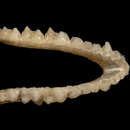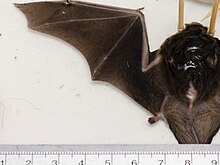en
names in breadcrumbs


Miniopterus australis is an echolocator. These animals use high pitch frequencies to locate their prey and avoid obstacles while flying. Because they are an edge habitat species, they use a mix of FM and CF calls.
As mammals, it is likely that they use some visual cues to communicate, as well as scent (especially the mother locating her young in the nursury cave). Tactile communication undoubtedly takes place in the somewhat crowded caves, as well as between mothers and their offspring and mates.
Communication Channels: tactile ; acoustic ; chemical
Perception Channels: visual ; tactile ; acoustic ; ultrasound ; echolocation ; chemical
Miniopterus australis is abundant in Indonesia, New Guinea, and the northeastern coast of Australia. Because they are not a threatened or endangered species, there are no attempts to legally protect them. There is no special status for M. australis on either the IUCN or CITES lists.
CITES: no special status
IUCN Red List of Threatened Species: least concern
There was no information found on negative impact of M. australis.
Miniopterus australis is insectivorous, and likely consumes insect pests.
Positive Impacts: controls pest population
The most information that was found on the ecosystem roles of M. australis is that they are predators of small bugs. They probably havve some effect on local insect populations. To the extent that they and are also prey for pythons, owls, ghost bats, foxes, and beetles, they may help provide nourishment for those predatory species.
Miniopterus australis emerge in the evening to forage. Using echolocation, they fly between shrub and canopy layers of extremely wooded areas and prey on the small bugs under the canopy.
Animal Foods: insects
Primary Diet: carnivore (Insectivore )
Miniopterus australis inhabits the subtropical coastal regions of Indonesia, Philippines, New Guinea, and Australia. In Australia, its range does not exceed the north-eastern coast. Miniopterus australis has a southern range limit in north-eastern New South Wales with a latitude of 31°15' S. The southern limit may be due to the close relationship M. australis has with Miniopterus schreibersii (common bent-wing bat).
Biogeographic Regions: oriental (Native ); australian
Most M. australis roost in caves, but it is also known to roost in abandoned mines, tunnels, water drains, buildings, and tree hollows. The nursery sites are usually located in limestone caves. They appear to forage in environments at the edges of forests.
It appears that M. australis is reproductively dependent on M. schreibersii for warmth in these caves. Miniopterus schreibersii is almost twice the size of M. australis, and heat the cave nicely for the young of both species. This could be why the range of M. australis is concurrent with the southern range of M. schreibersii. Miniopterus australis does not migrate to a winter roost.
Habitat Regions: temperate ; tropical
Terrestrial Biomes: forest
Other Habitat Features: caves
The oldest recorded age of M. australis is five and a half years. This is based on an individual that was captured, marked, and recaptured. It is quite possible that they do live longer, but it has never been recorded.
Range lifespan
Status: wild: 5.5 (high) years.
Miniopterus australis lacks a nose leaf. It appears grayish-black, but changes color during the year to a fawnish-brown. A closer look reveals a coat with pale brown under-fur topped with a chocolate brown color. Both males and females molt. However, females tend to molt later than males because they may be lactating during the normal time of molting.
Miniopterus australis is closely related to and looks much like M. schreibersii, but is slightly smaller. It weighs 7 to 8 g and has a total length of 86 to 96 mm. Males and females do not exhibit any type of dimorphism; they are relatively the same size and weight, except for pregnant females who will gain 2 to 3 g. The tail is just as long as the head and body together (43 to 48 mm), and the haired patagium covers most of the tail. The forearm of this species is a total of 36 to 40 mm long.
Range mass: 7 to 8 g.
Range length: 86 to 96 mm.
Other Physical Features: endothermic ; heterothermic ; bilateral symmetry
Sexual Dimorphism: sexes alike
As individuals of M. australis fly from their shelters, they will sometimes be snatched by pythons or ghost bats (one of the predatory bat species). Other common predators are owls and foxes. Many young may fall to the floor of the nursery roost and be overtaken by beetles that inhabit the area.
Known Predators:
No information was found on the mating systems of M. australis.
Miniopterus australis start to reproduce after 21 months of age. Copulation activity occurs during the winter months of June and July. Once mated, the females do not store the sperm; fertilization takes place right away in August. Although there is no delayed implantation, retarded embryonic development is experienced. The retarded development lasts from August to mid-September, when normal development resumes.
Miniopterus australis, like M. schreibersii, chooses specific sites for nurseries in which to rear young. These nurseries are used year after year, with both species often together in one site. Miniopterus australis gives birth in the summer month of December after a gestation period of about four months.
Although no reports were found for M. australis, newborn M. schreibersii weigh between 2 nd 3 g. Weaning of M. schreibersii occurs at about 2 months of age. Miniopterus australis is probably similar.
Breeding interval: These bats appear to breed annually.
Breeding season: Breeding occurs in June and July.
Range number of offspring: 1 to 1.
Range gestation period: 180 to 195 days.
Average age at sexual or reproductive maturity (female): 21 months.
Average age at sexual or reproductive maturity (male): 21 months.
Key Reproductive Features: iteroparous ; seasonal breeding ; gonochoric/gonochoristic/dioecious (sexes separate); sexual ; fertilization ; viviparous ; embryonic diapause
Miniopterus australis is considered a juvenile up to 9 months, a yearling between 9 and 21 months, and an adult after 21 months of age. Mothers tend to the young, nursing and grooming them, but sometimes find that the cave becomes too warm. To cool themselves off, the mothers will leave the young hanging alone in the cave amd exit to the cool outdoors. Male parental care has not been described in this species.
Parental Investment: no parental involvement; altricial ; pre-fertilization (Protecting); pre-hatching/birth (Provisioning: Female, Protecting: Female); pre-weaning/fledging (Provisioning: Female, Protecting: Female); pre-independence (Protecting: Female)
The little bent-wing bat or little long-fingered bat (Miniopterus australis) is a species of vesper bat in the family Miniopteridae. It is found in Australia, Indonesia, the Philippines, and Vanuatu.
The species was first described by Robert Tomes in his 1858 monograph of the genus. Tomes distinguished the new species with a comparison to Miniopterus blepotis, in details of morphology and fur, and with standardised measurements using the breadth of the forearm; M. bleopotis was assigned in the broadly dispersed Miniopterus schreibersi species complex.[2] The type locality is named as Lifu in the Loyalty Islands, a province of New Caledonia.[3] Tomes assigned the specific epithet australis when he first regarded the population as endemic to Australia, but realised the series of specimens he assembled for his revision included those collected in Timor and presumed they also occurred at other islands of the regions. While recognising this as a misnomer, Tomes noted he had already applied this name in museum collections prior to publication and conserved his first choice to avoid any subsequent confusion.[2]
The author also noted a specimen from the Leyden Museum in his monograph, previously exhibited at that institution with the name Vespertilio tibialis but did not appear in a formal description.[2] The taxonomic history of this species and its infraspecific arrangement was complicated by uncertainty regarding the sources of specimens, clarified in part by James E. Hill's monograph on the genus,[4] then a statistical analysis of characters using a large sample of specimens by Darrell Kitchener and A, Suyanto in 2002 that also determined type locations for three subspecies and other undiagnosed specimens.[5]
Following these revisions, three subspecies were recognised:[3]
Revisions in the late twentieth century recognised other named taxa as subspecies, but subsequent revisions saw cause for elevation to species status, namely Miniopterus paululus, to which the subspecific name witkampi also refers, and Miniopterus shortridgei.[3]
The conservation status of the species was evaluated in 2008 as "least concern", and the population trend was assumed to be stable. Misattribution between this and other species of Miniopterus in Indonesia, the Philippines and New Guinea islands has led to taxonomic uncertainty and therefore doubt on any population's trajectory. The broad distribution range is presumed to include the protection afforded by conservation areas.[1]
The little bent-wing bat or little long-fingered bat (Miniopterus australis) is a species of vesper bat in the family Miniopteridae. It is found in Australia, Indonesia, the Philippines, and Vanuatu.
 Miniopterus australis (Unknown subspecies), underside
Miniopterus australis (Unknown subspecies), underside